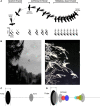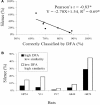Probing the natural scene by echolocation in bats
- PMID: 20740076
- PMCID: PMC2927269
- DOI: 10.3389/fnbeh.2010.00033
Probing the natural scene by echolocation in bats
Abstract
Bats echolocating in the natural environment face the formidable task of sorting signals from multiple auditory objects, echoes from obstacles, prey, and the calls of conspecifics. Successful orientation in a complex environment depends on auditory information processing, along with adaptive vocal-motor behaviors and flight path control, which draw upon 3-D spatial perception, attention, and memory. This article reviews field and laboratory studies that document adaptive sonar behaviors of echolocating bats, and point to the fundamental signal parameters they use to track and sort auditory objects in a dynamic environment. We suggest that adaptive sonar behavior provides a window to bats' perception of complex auditory scenes.
Keywords: action-perception; auditory scene analysis; hearing; neuroethology; stream segregation.
Figures








Similar articles
-
Auditory scene analysis by echolocation in bats.J Acoust Soc Am. 2001 Oct;110(4):2207-26. doi: 10.1121/1.1398051. J Acoust Soc Am. 2001. PMID: 11681397
-
Echo-acoustic flow shapes object representation in spatially complex acoustic scenes.J Neurophysiol. 2017 Jun 1;117(6):2113-2124. doi: 10.1152/jn.00860.2016. Epub 2017 Mar 8. J Neurophysiol. 2017. PMID: 28275060 Free PMC article.
-
Adaptive echolocation behavior of bats and toothed whales in dynamic soundscapes.J Exp Biol. 2023 May 1;226(9):jeb245450. doi: 10.1242/jeb.245450. Epub 2023 May 10. J Exp Biol. 2023. PMID: 37161774 Free PMC article.
-
Sensing in a noisy world: lessons from auditory specialists, echolocating bats.J Exp Biol. 2017 Dec 15;220(Pt 24):4554-4566. doi: 10.1242/jeb.163063. J Exp Biol. 2017. PMID: 29237765 Review.
-
Adaptive Echolocation and Flight Behaviors in Bats Can Inspire Technology Innovations for Sonar Tracking and Interception.Sensors (Basel). 2020 May 23;20(10):2958. doi: 10.3390/s20102958. Sensors (Basel). 2020. PMID: 32456142 Free PMC article. Review.
Cited by
-
The organization of exploratory behaviors in infant locomotor planning.Dev Sci. 2017 Jul;20(4):10.1111/desc.12421. doi: 10.1111/desc.12421. Epub 2016 May 4. Dev Sci. 2017. PMID: 27147103 Free PMC article.
-
Species-specific control of acoustic gaze by echolocating bats, Rhinolophus ferrumequinum nippon and Pipistrellus abramus, during flight.J Comp Physiol A Neuroethol Sens Neural Behav Physiol. 2016 Nov;202(11):791-801. doi: 10.1007/s00359-016-1121-0. Epub 2016 Aug 26. J Comp Physiol A Neuroethol Sens Neural Behav Physiol. 2016. PMID: 27566319 Free PMC article.
-
Echolocating bats use future-target information for optimal foraging.Proc Natl Acad Sci U S A. 2016 Apr 26;113(17):4848-52. doi: 10.1073/pnas.1515091113. Epub 2016 Apr 11. Proc Natl Acad Sci U S A. 2016. PMID: 27071082 Free PMC article.
-
3D Hippocampal Place Field Dynamics in Free-Flying Echolocating Bats.Front Cell Neurosci. 2018 Aug 23;12:270. doi: 10.3389/fncel.2018.00270. eCollection 2018. Front Cell Neurosci. 2018. PMID: 30190673 Free PMC article.
-
Acoustic evaluation of behavioral states predicted from GPS tracking: a case study of a marine fishing bat.Mov Ecol. 2019 Jun 14;7:21. doi: 10.1186/s40462-019-0163-7. eCollection 2019. Mov Ecol. 2019. PMID: 31223482 Free PMC article.
References
-
- Au W. W. L. (1993). The Sonar of Dolphins. New York: Springer
-
- Aytekin M., Grassi E., Sahota M., Moss C. F. (2004). The bat head-related transfer function reveals binaural cues for sound. - PubMed
-
- Barak Y., Yom-Tov Y. (1989). The advantage of group hunting to Kuhl's pipistrelle bat Pipistrellus kuhli (Microchiroptera). J. Zool. 219, 670–67510.1111/j.1469-7998.1989.tb02608.x - DOI
LinkOut - more resources
Full Text Sources

